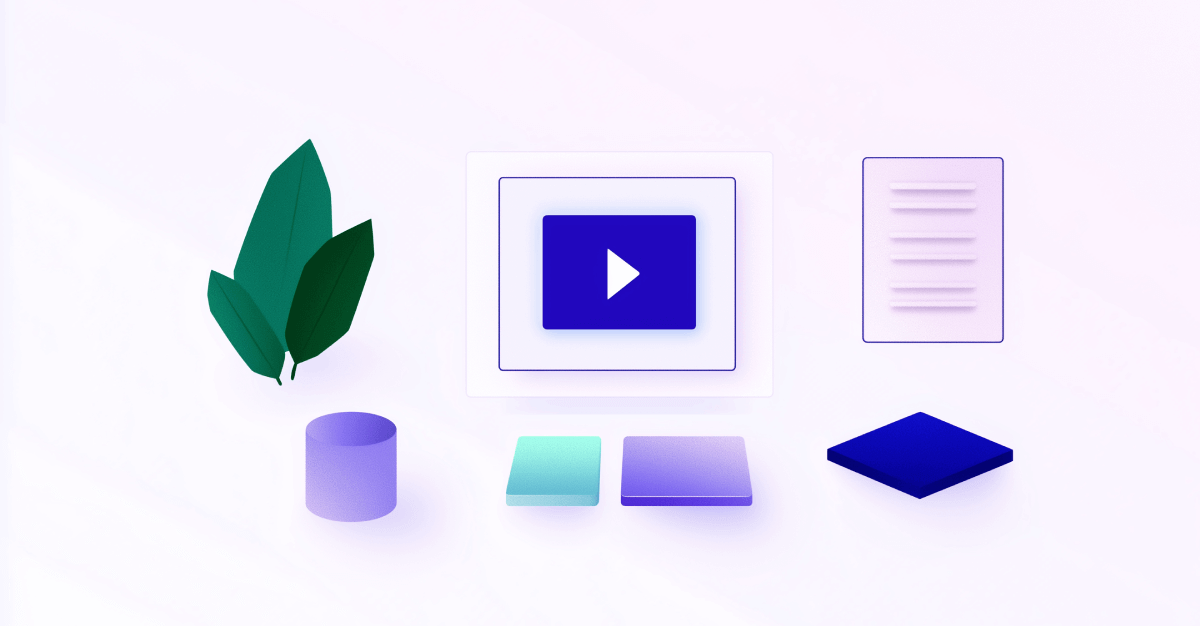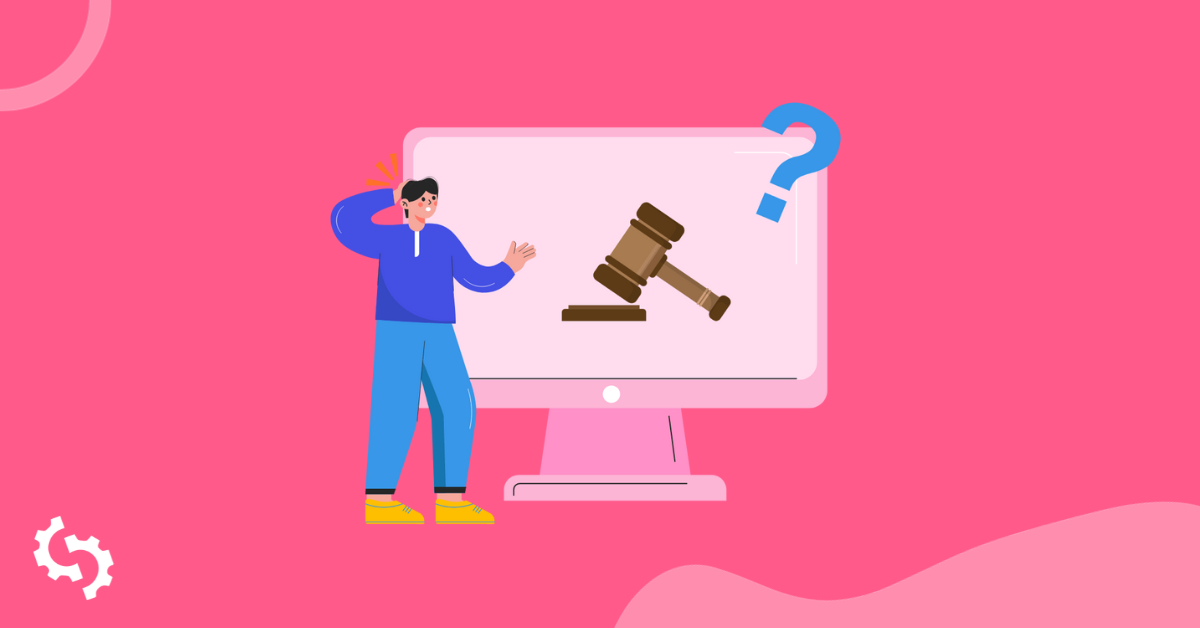
Google is a club all of its own.
And just like in any club, there are rules to follow if you want to be included.
Violate those rules, and you'll get a penalty.
If one or more actions on your website (or toward it) violate Google’s Webmaster Guidelines for indexable content, it can trigger a Google penalty that puts your site at a huge risk in search results.
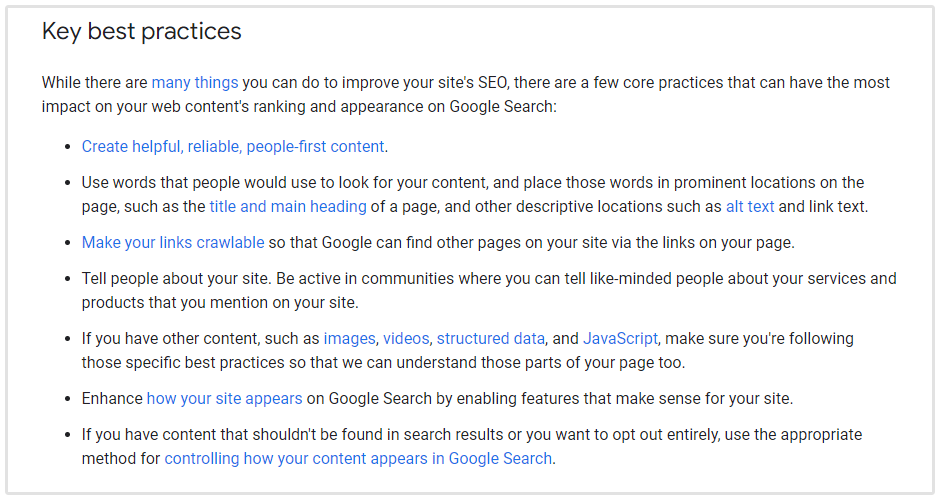
Sometimes you might even see it completely disappear from the SERPs.
If you've found yourself in that position, follow this Google penalty removal guide to undo the damage and get back in Google's good graces.
Types of Google Penalties
Google assigns two types of penalties: algorithmic penalties and manual actions.
Thankfully there are only two, but don't let out a breath of relief already—these two give you plenty to deal with!
Algorithmic Penalties
When you hear that websites have been hit by strange beasts called Panda, Penguin, Hummingbird or Payday, what you're hearing about are Google's core algorithm updates.
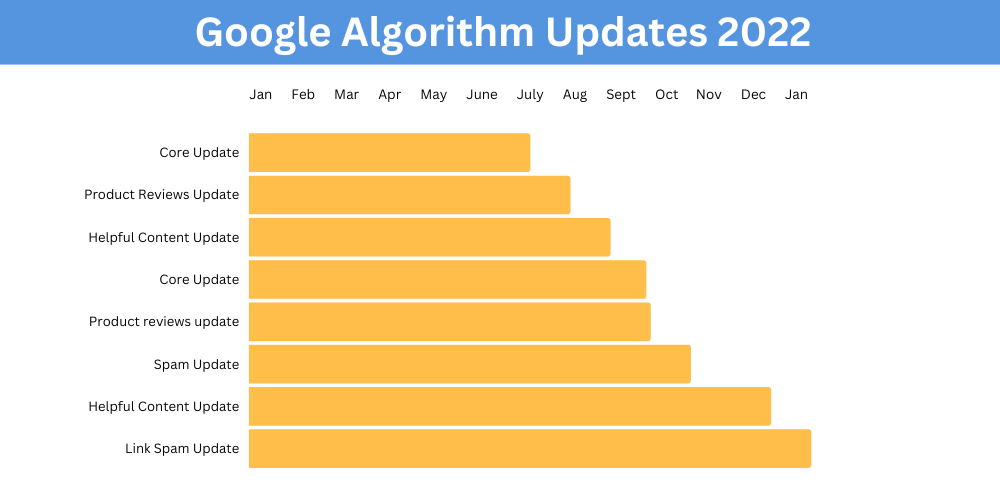
These updates always bring along both good and bad news for webmasters.
For example:
- Sites hit by Panda (the "content penalty") have filled the web with low quality content, including thin and duplicate content, as well as content farming.
- Sites hit by Penguin (the "link penalty") have committed the crime of creating link schemes (think non-social link exchanges and paid links), with keyword stuffing to add some flavor.
And these are just a couple of examples.
Moz has a full list of Google core updates from the beginning of time that's quite intimidating if you stare at it for too long.
Every time Google releases a new algorithm update, it means they've spotted something in the SEO and webmaster realm that they don't like quite so much. The update gives webmasters and SEOs a wake up call, and tells everybody that things are going to change from now on.
Algorithm updates are designed to push webmasters, both in the profession and as hobbyists, to review our websites and marketing practices to make sure we're doing a good job.
So that's the thing with algorithmic penalties:
They tell you that there are whole new standards at Google, and that your website must meet those standards the next time around.
Manual Actions
Manual actions are issued against your site by a human reviewer at Google. If you've received a manual action, it's because the reviewer found that your site doesn't meet their Webmaster Guidelines.
In one of their support pages, Google lists the types of manual actions or penalties that can be applied to your site. You can get a manual penalty for:
- User-generated spam
- Structured data issues
- Unnatural links to/from your site
- Thin content with little or no added value
- Cloaking and sneaky redirects
And the list goes on.
As you can probably gather, manual penalties target spammy and deceptive behavior. These are usually more serious (and harder to remove) than an algorithmic penalty, but it is possible.
I'll go into these penalty removal methods a little later in the post. But first, how do you know if your site has been penalized?
How to Know if You Have a Google Penalty
If you've received a manual action, you'll have a message report from Google in Search Console to tell you.
But in the case of algorithmic penalties, it's usually not until you've seen the damage that you'll know you've been penalized in the first place.
The first sign of a Google penalty will usually be one or more of the following:
- Drop in rankings
- Drop in traffic
- Deindexation
Let's look at these in more detail.
Drop in Rankings
You might get a hint of a ranking loss when you search Google for your main keywords and notice that they've receded in the SERPs, farther and farther away from the first page (or where you were earlier).
This is a warning signal that something is wrong, and that there may be a penalty applied to your website.
I suggest that you constantly check and monitor your keywords in Google to act promptly should a penalty come up
What to do until the penalty is removed
It might take some time to lift the penalty, so in the meantime, you need to do what you can to mitigate the damage from lost keyword rankings.
Use other search channels to keep your website being found.
These channels include social media like Twitter, Facebook and Instagram, communities, niche forums and industry directories. Craigslist is also a good way to get found.
Moreover, this is a good time to participate in offline events like conferences and meetups to help you create visibility and get found by your target audience.

Drop in Traffic
Another signal that Google has assigned you a penalty is if you notice a drop in traffic in your Google Analytics or other analytics package.
As Illia Termeno, Director at Extrabrains, explains:
If you sell products or services on your website, you might also notice a decline in referrals, sales and overall conversions."You will need to analyze your traffic to determine if your website is being impacted. If you notice a significant drop in organic traffic and Google’s ranking, you will need to find a correlation between Google’s last algorithmic changes and your website’s losses.
If you find that you were harmed by a specific algorithm change, get all the information you can about that update so you can start to resolve the issue. You will have to make changes to ensure that your website complies with Google Webmaster Guidelines."
What to do until the penalty is removed
The best way to limit the damage until then is to use other traffic generation channels, like your list or newsletter, community management, subscription incentives and social networks.
You can also look to other search engines, like Bing.
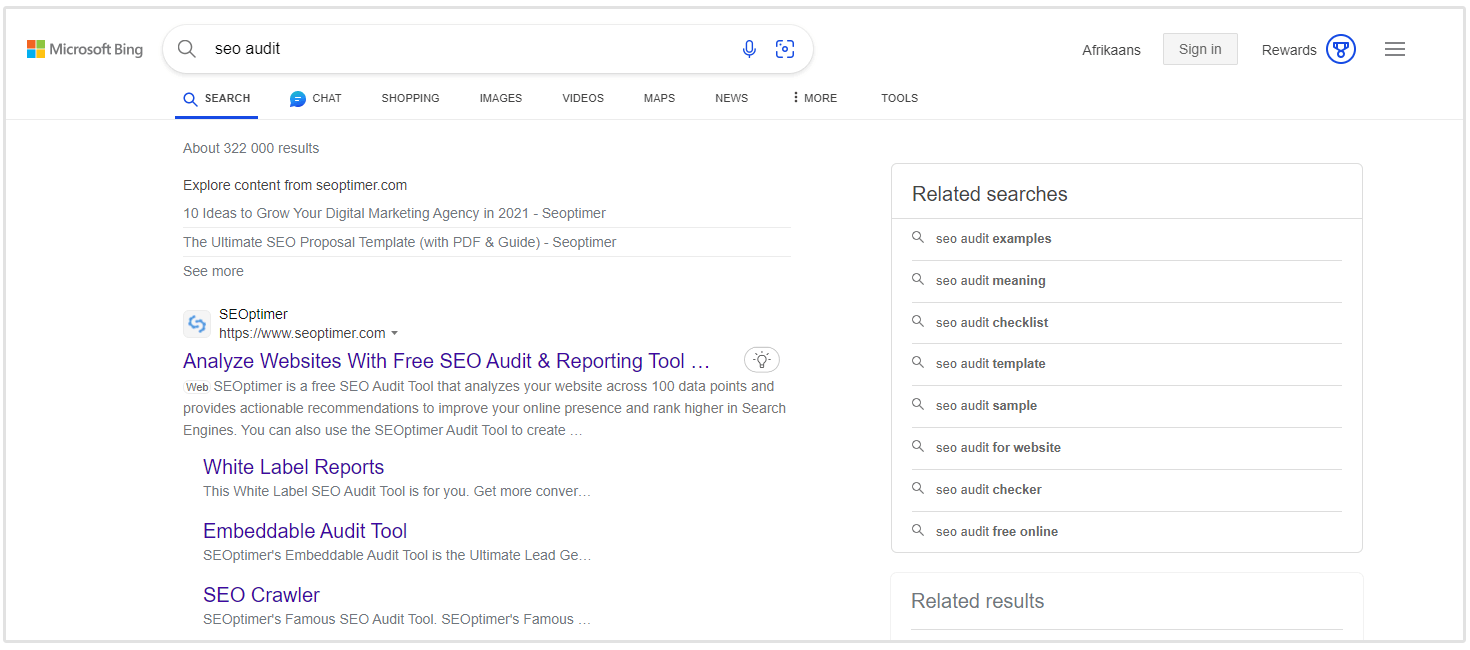
Deindexation
One day, you might look up your website on Google for whatever reason, and you can't find it anymore.
Not even the search operator "site:yoursitename.ext" can help you find it.
This means that your website was completely removed from the Google index.
But, Google may have removed only a portion of your site. In that case, you'll find that many of your pages are missing, and that a small or large part of your site has been deindexed.
Generally, massive spam and deception are the most frequent causes of deindexation, but algorithmic penalties may also cause partial or complete removal from search results.
What to do until the penalty is removed
Until your website is fully restored in the SERPs, you'll have to rely completely on other channels for incoming traffic, conversions and overall visibility.
Because your website is partially or completely absent from Google in this case, you can't even rely on partial Google traffic like with the other two cases.
My advice is to leverage your community, especially your list or newsletter, as well as any traffic that's coming from niche directories and other search engines.
Seek interaction with other professionals in your niche, using word of mouth and threads in forums and online communities.
Now, let's find out how to remove that penalty pronto and get your rankings back!
4 Google Penalty Removal Actions You Can Take
In general, there are four things you can do to get a Google penalty removed.
(We'll dive into the specifics in the next section.)
1. Use the Disavow Tool
Link penalties are very common, and the only way to remove a link penalty is to remove the backlinks that caused the penalty.
This is done by creating a disavow file of all the toxic links you found in your backlink profile, and then submitting the file to Google's Disavow Links Tool to devalue those linking signals.
Just select your domain:
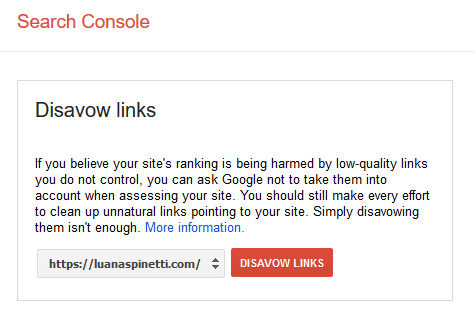
Upload your disavow file in .txt format:
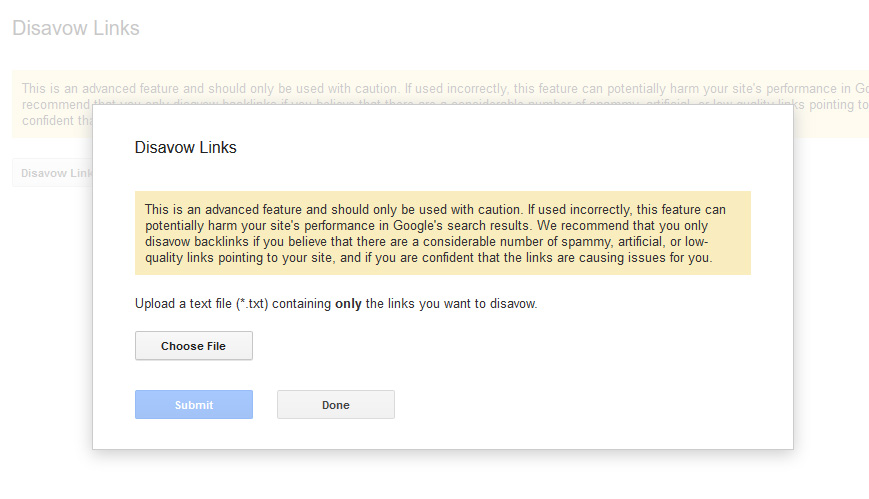
2. Fix Your Website to Adhere to Google's Guidelines
Getting your website up to Google's standards is the best way to shake (and prevent) a penalty.
The best way to do this is to read Google's Webmaster Guidelines in their entirety and make an effort to apply them almost verbatim.
(No kidding, you never know how Google might interpret them! It's better to play it safe.)
Obviously that might not be sufficient to avoid an algorithmic or manual penalty entirely in the future, but it'll make the case for it happening much, much less likely.
Also, make sure to read reputable SEO blogs to stay up to date with news, best practices, case studies and strategies, and to replicate any that you think may benefit your site in the long term. Good ones to follow include Search Engine Land, Search Engine Roundtable, and of course, the SEOptimer blog.
3. Improve Content Quality for Users
What kind of content does Google like?
Content that's helpful to users, of course!
Just think about the Medic update in August 2018. It was all about expertise, authority and trust (E-A-T), so that means that Google wants you to give users exactly that and to make their time spent on your site the best experience possible.
Apply high standards to your content, and you'll stay safe from penalties.
4. Submit a Reconsideration Request
This is the step to take after you've cleaned up your website and backlink profile to adhere to Google's guidelines.
You need to document the actions you took to meet those guidelines, and upload those documents together with a brief summary of what you've done and why.
Google will then take another look at your site and (hopefully) remove the penalty!
You can reach the reconsideration request form through your manual action report in Google Search Console, or by clicking here.
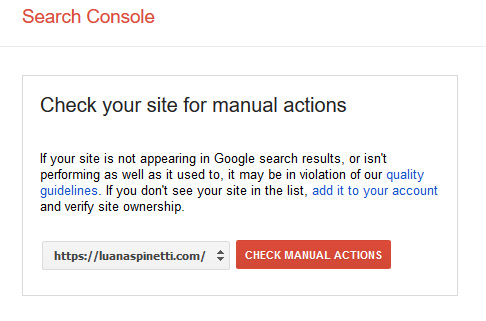
Fill out the form with a thorough explanation of what you've done to fix the issue, add an apology and submit the request.
How to Remove Manual Penalties
I took you through the basic Google penalty removal steps above. But when it comes to removing a specific manual penalty, there's still more to do before you can ask Google to reconsider.
Here's what you need to do to remove the following manual penalties from your site:
Unnatural Links to/from Your Site
Google has always been big about increasing your backlink signals through natural links.
When you pay a link seller to build links for you or fill your blog with paid links, engage in non-social link exchange (i.e. link exchange that's clearly not a genuine exchange of links between partners or blog buddies, but part of a link scheme to artificially manipulate search engine rankings), or scatter links around blogs, forum profiles and comments with the sole scope of increasing your SERPs position, then Google isn't going to be nice about it.
When Google discovers the unnatural backlinks, manual reviewers will derank your website in the SERPs and send you an "Unnatural links to/from your site" message in the Search Console report dashboard.
How to remove the penalty
Clean up that backlink profile!
Paul Martin, Digital Strategy Director at Jaywing Australia, recommends looking into:
- "Anchor text: Anything 'spammy,' which includes exact match keywords.
- Domains: Is the linking site reputable?
- Context: Is the link on a legitimate webpage and is it surrounded by other legitimate content (i.e. if you sell shoes, make sure that your link doesn't sit next to a car insurance link, for example)."
With your list of bad links in hand, the next step is to contact webmasters to ask for link removal.
This won't always be successful, and when it's not, that's when you can submit a disavow file to Google like we discussed above.
Pure Spam
Google defines pure spam as a website that's been created solely for spamming. Think aggressive advertising without bringing value and valid content to users.
When one of my blogs got this manual action years ago, it completely disappeared from Google SERPs.
Yeah, I'm talking about a complete deindexation. Poof, gone. That's what Google does to a website that it deems as "pure spam."
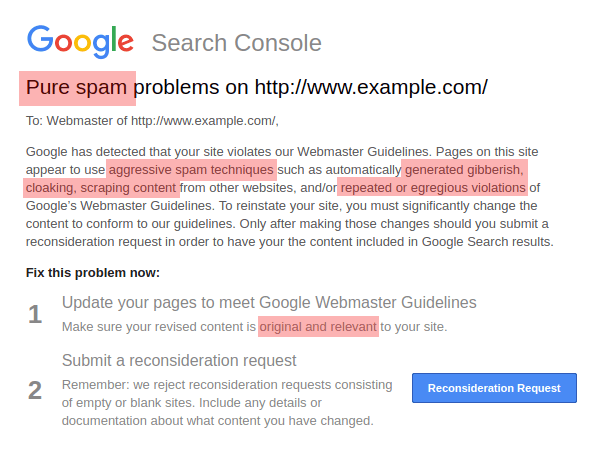
Although my website hadn't been created for spam, a human reviewer at Google must have deemed it malicious because it was a character blog (i.e. a fictional blog where I role-played a character) where I welcomed ads and sponsored posts.
Unlike what Google says about the "pure spam" manual action, there was no auto-generated gibberish, cloaking or scraped content on my poor blog—only a few sponsored posts mixed with storyline posts.
Unfortunately, I never managed to get the site back in Google before I closed it—but you might be luckier, after all!
How to remove the penalty
The only way out of this dark pit is to try to understand why Google thought your website to be "pure spam," especially if—as it happened to my character blog—that's really not the case.
A Google reviewer might've mistakenly considered your website to be a spam site and not helpful for Google users, or the issue might've come from a previous owner of the domain (give Archive.org a try to check the site history).
SEO expert Marie Haynes suggests that you get to work cleaning up your website inside and out, removing any auto-generated content, scraped content and black hat signals, and adding more value (e.g. creating new content that really helps your target users).
Thin Content with Little or No Added Value
Thin content is all that content where the amount of text is minimal, and often it's not helpful to the user who's coming to your page to find a solution to their problem.
For example, displaying a list of emergency phone numbers without any other information about best calling practices or how to report an emergency makes for a really thin page that would better suit a personal sticky note than a webpage.
A simple uncommented list doesn't constitute sufficient content for the user, at least according to Google. Neither does scraped and duplicated content, auto-generated content or doorway pages (and rightfully so).
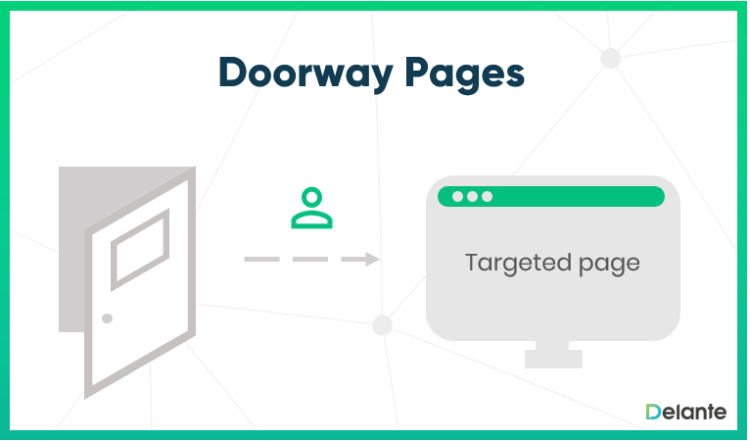
Image source: Delante
This manual penalty can result in partial deindexing of pages that Google considers to be thin content.
How to remove the penalty
Update thin content pages to make them really useful to users, or just downright delete them.
Some ideas:
- Turn previously written content into more in-depth content, complete with images and data
- Make simple lists into helpful guides or tutorials
- Add a rel=canonical attribute to pages that were accidentally made into duplicate content
- Remove any scraped content and write new content yourself or hire a writer to do so
User-generated Spam
User-generated spam is the type of spam that you find on forums and multi-user blogs, where users can write and publish their own content with or without editorial review.
This manual penalty exists to discourage overly-permissive community management that gives a free pass to any content users want to publish, and serves as a push for the site owner to ensure that users only publish quality content.
So that means no spam, no self-generated text and no excuses to fill the web with toxic links. The same applies to blog comments, too.
How to remove the penalty
Lifting this penalty means telling users to modify the offending content (and they've got to comply or here falls a temporary suspension or ban!), and enforcing new guidelines for the creation and management of content.
If they refuse to collaborate, go ahead and delete the content (but allow them to download a backup).
The new guidelines for your community must involve a more rigid editorial review and quality-oriented guidelines for the publication of new content.
This isn't just for your users—you need to be able to show Google that you've done the work to improve your community when you submit a reconsideration request to get the penalty lifted.
Cloaking and Sneaky Redirects
Google doesn't like it when webmasters show users one thing and Google a completely different one.
The two versions have to match somehow!
So whenever a Google reviewer finds out that a webpage shows differently to Google and to users, they can assign this manual penalty.
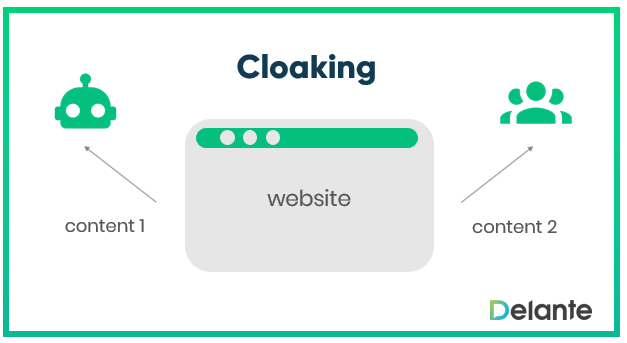
Image source: Delante
How to remove the penalty
If you run a subscription site or have gated/paywalled content for members, Google advises using structured data to tell the algorithm and human reviewers that you're not using cloaking or sneaky redirects to deceive users and Googlebot.
In all other cases, use the URL Inspection Tool in Google Search Console to look at your content as it's seen by Googlebot and by a user.
Whenever you find differences, correct either of the two versions and remove any accidental redirects.
After you've done that, you can submit a reconsideration request to Google.
Hidden Text and Keyword Stuffing
Google has always frowned upon the black hat practices of hidden text and keyword stuffing, because they clearly and solely exist to manipulate search engines.
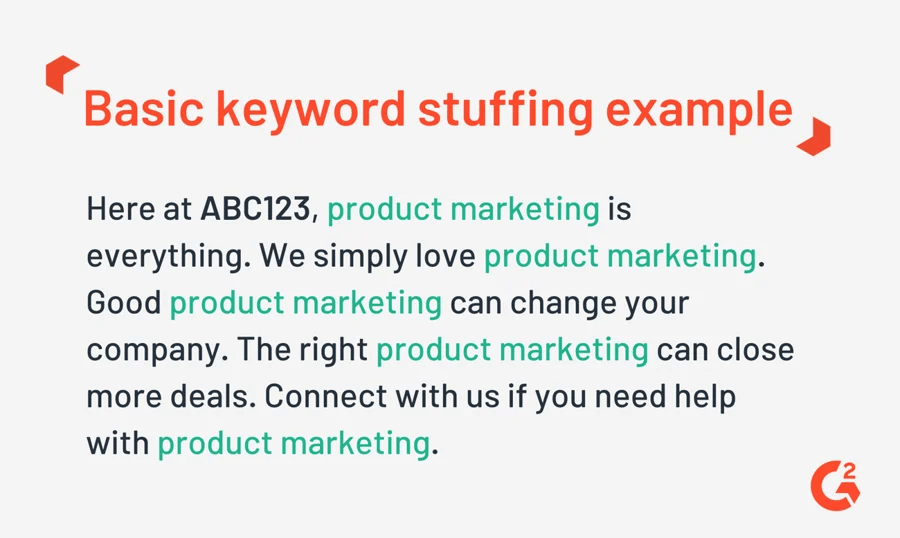
Hiding text through HTML or CSS tricks and stuffing keywords everywhere in the code of the page can artificially (and only for a short time) boost rankings.
But it doesn't help Google distribute the right content to its users, who wind up being shown tons of results that don't match their search query.
(Super frustrating!)
It doesn't surprise that Google is against this practice and penalizes any website caught using it.
How to remove the penalty
Clean your website of all the hidden text and non-relevant or repeated keywords, then send a reconsideration request to Google.
Spammy Free Host
Getting free hosting for your website may sound cool, but I suggest that you take a good close look at the service you're about to try before running the risk of a manual action.
Some free hosting providers clutter their users' webpages with tons of malicious ads (especially those nasty pop-unders!), à la the old Geocities and Angelfire. When the amount of spam reaches egregious levels, Google might decide to penalize the whole service and not only single websites.
Or it might be the service users' fault.
One such example is the co.cc free registrar that got completely erased from Google in 2011 as a consequence of massive spam caused by users.
How to remove the penalty
Nothing to do here but to change hosting provider and/or domain registrar, pronto!
Sneaky Mobile Redirects / AMP Content Mismatch
Like with the other "Sneaky redirects" penalty, Google doesn't like when webmasters show mobile users different content than to desktop users.
Even more so if the mobile pages you're trying to get indexed and ranking well are optimized as AMP.
This manual action can lead to partial or total deindexation.
How to remove the penalty
Google wants you to show the same content (albeit in different formats, designs and resolutions) to its users, so make sure to check all of your pages to achieve just that.
Pay special attention to the AMP content and to its markup.
Submit a reconsideration request afterward.
A Link Penalty Story: How I Removed a Client's Google Penalty by Cleaning Up Their Links
Back in 2014, I was working as a content writer and social media manager for a client in India.
Because I was also offering SEO help as a professional "addon" to our contract, my client came to me every time something didn't look right in his SEO strategy.
One day this client emailed me urgently to let me know that Google had penalized his website for unnatural incoming links.
Since the website we were working on was rather new, I asked him if he'd bought link packages from a link seller.
He admitted that yes, he and his business partner had bought dozens of backlinks from a guy who sold them in packages for cheaps (probably from Fiverr or a similar service), thinking that they'd quickly climb the SERPs with these new link signals.
The Solution
After a brief talk about the whole story, I asked my client to give me access to his Webmaster Tools (now Search Console) and Google Analytics accounts so that I could take care of the problem.
And yes, there it was: the glaring "Unnatural links to your site" manual action in my client's Webmaster Tools reports dashboard.
Google Analytics hadn't shown a drop in traffic as of yet, but I knew it'd be coming soon.
I found that the new backlinks were, in fact, all low quality and spammy. Most of them were footer, sidebar and link exchange page backlinks.
That stuff had pretty much no value!
But at least I knew what I had to do:
Remove the spammy and toxic links from my client's backlink profile, and then submit a reconsideration request to Google.
The Cleanup
It was a bit of a headache to get the penalty lifted.
My client's backlink profile was riddled with toxic links that I had to manually add to an Excel spreadsheet.
Then I went on to email webmasters on my client's behalf to ask that they remove the bad backlink. Many webmasters were kind and removed the backlinks, but in many other cases I received no response whatsoever.
So, I added those backlinks to a disavow file and sent it to Google to have them devalued. Then, I sent a reconsideration request to Google with the details of how I'd cleaned up the backlink profile to the best of my abilities.
Luckily, this story has a happy ending:
Within two weeks of submitting the disavow file and reconsideration request to Google, my client got his penalty lifted, and his traffic and rankings back.
The timely "cleansing" work paid off!
Google Penalty Removal Wrap-up
As you can see, the Google penalty removal process involves acting quickly, making sure that your website is completely clear of any elements that go against Google's guidelines, and asking Google to reconsider the penalty.
So as soon as you discover that your website has received a Google penalty, it's important to act promptly.
Start with an assessment of the last actions done on the site (on-page SEO, mobile optimization, etc.).
Consider outside actions as well, like link building methods that might've gone bad (buying links from untrusted sources or getting your guest post syndicated as-is to bad sites), or even backlink changes that brought in bad signals (maybe the site owner moved your backlink to a new domain that they didn't know was penalized).
But at the end of the day, don't fear Google penalties too much.
Most of the time, they can be fixed. It's just a matter of getting things right and to keep them going right the next time.
Good luck!




